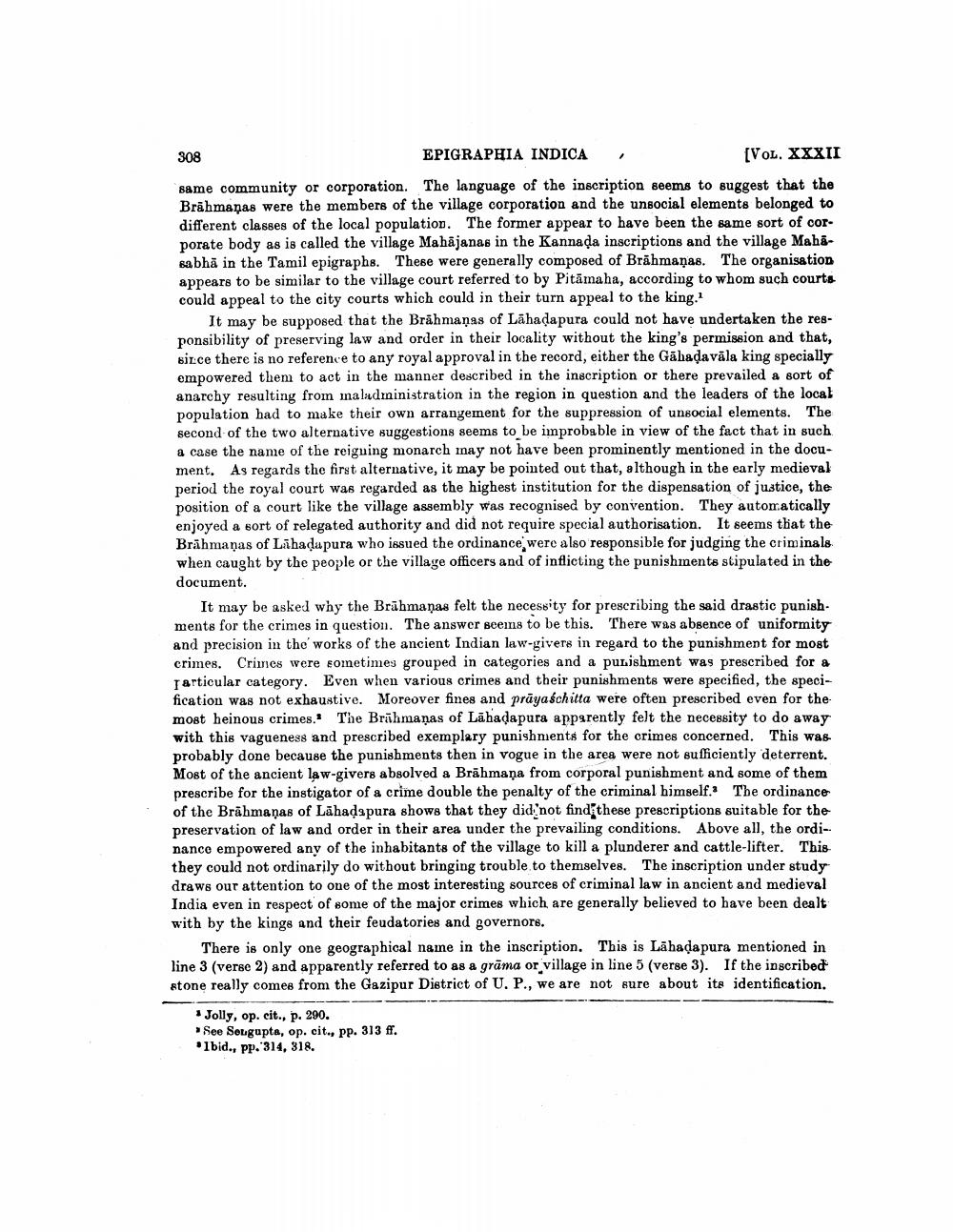________________
308
EPIGRAPHIA INDICA
,
[VOL. XXXII
same community or corporation. The language of the inscription seems to suggest that the Brāhmaṇas were the members of the village corporation and the unsocial elements belonged to different classes of the local population. The former appear to have been the same sort of corporate body as is called the village Mahājanas in the Kannada inscriptions and the village Mahasabhā in the Tamil epigraphs. These were generally composed of Brahmanas. The organisation appears to be similar to the village court referred to by Pitāmaha, according to whom such courts could appeal to the city courts which could in their turn appeal to the king.
It may be supposed that the Brāhmaṇas of Lāhadapura could not have undertaken the responsibility of preserving law and order in their locality without the king's permission and that, since there is no reference to any royal approval in the record, either the Gäbadavāla king specially empowered them to act in the manner described in the inscription or there prevailed a sort of anarchy resulting from aludninistration in the region in question and the leaders of the local population had to make their own arrangement for the suppression of unsocial elements. The second of the two alternative suggestions seems to be improbable in view of the fact that in such a case the name of the reiguing monarch may not have been prominently mentioned in the document. As regards the first alternative, it may be pointed out that, although in the early medieval period the royal court was regarded as the highest institution for the dispensation of justice, the position of a court like the village assembly was recognised by convention. They automatically enjoyed a sort of relegated authority and did not require special authorisation. It seems that the Brāhmaṇas of Lihadapura who issued the ordinance were also responsible for judging the criminals when caught by the people or the village officers and of inflicting the punishments stipulated in the document.
It may be asked why the Brühmanas felt the necessity for prescribing the said drastic punishments for the crimes in question. The answer seems to be this. There was absence of uniformity and precision in the works of the ancient Indian law-givers in regard to the punishment for most crimes. Crimes were sometimes grouped in categories and a punishment was prescribed for a particular category. Even when various crimes and their punishments were specified, the specification was not exhaustive. Moreover fines and prayaschitta were often prescribed even for the most heinous crimes.' The Brāhmaṇas of Lāhadapura apparently felt the necessity to do away with this vagueness and prescribed exemplary punishments for the crimes concerned. This was probably done because the punishments then in vogue in the area were not sufficiently deterrent. Most of the ancient law-givers absolved a Brāhmaṇa from corporal punishment and some of them prescribe for the instigator of a crime double the penalty of the criminal himself. The ordinance of the Brāhmaṇas of Lāhadapura shows that they did not find these prescriptions suitable for the preservation of law and order in their area under the prevailing conditions. Above all, the ordinance empowered any of the inhabitants of the village to kill a plunderer and cattle-lifter. This they could not ordinarily do without bringing trouble to themselves. The inscription under study draws our attention to one of the most interesting sources of criminal law in ancient and medieval India even in respect of some of the major crimes which are generally believed to have been dealt with by the kings and their feudatories and governors.
There is only one geographical name in the inscription. This is Lāhadapura mentioned in line 3 (verse 2) and apparently referred to as a grāma or village in line 5 (verse 3). If the inscribed stone really comes from the Gazipur District of U. P., we are not sure about its identification.
* Jolly, op. cit., p. 290. See Sengupta, op. cit., pp. 313 ff. Ibid., pp. 314, 318.




